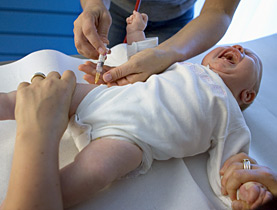
Needles may be headed for the scrapheap

Some vaccinations such as those being tested for HIV may no longer require the use of a needle, say Swiss and European scientists.
Aerosol vaccines could replace the common jab and would be particularly useful for immunisation programmes in developing countries where qualified medical staff and hygiene are often lacking.
Aerosol technology is one of the most recent methods being tested for large-scale vaccination campaigns.
“When you inject, there are health risks,” said Jean-Pierre Kraehenbuhl, one of the authors of a pan-European study published this week in the journal Proceedings of the National Academy of Sciences.
“In developing countries this can be a real problem. With aerosols, this is not a concern.”
For many people, the only concern is how much a jab will hurt. “Injecting large doses of vaccine is painful, and the pain factor is eliminated with this technique,” Kraehenbuhl told swissinfo.
The World Health Organization has been trialling aerosol vaccination for measles using small disposable devices that make vaccine distribution simple.
But until now it has not been considered for diseases that enter the body through mucosal pathways such as HIV, the virus that causes Aids. While there are only experimental vaccines for this disease, researchers wanted to know whether the aerosol technique was safe to use.
Tests were carried out on macaque monkeys. They were made to breathe in an experimental vaccine for HIV or human papillomavirus (HPV) through a mask. The vaccine, which contained radioactive markers, was inserted inside a vector, in this case viruses of the smallpox family.
“The idea is that there is no immune response to the vector, but only to the vaccine you inserted,” explained Kraehenbuhl, a member of the Swiss Institute for Experimental Cancer Research in Lausanne.
The researchers found the response was almost the same as if the macaques had received an injection of the vaccines. Side effects were minimal, at worst something like a cold.
The vaccines had also reached the mucosal tissues of the lungs and respiratory tract, and there were no traces in the animals’ brains or eyes, where they could be harmful.
“The problem with aerosol vaccination through the nose is there are cells there that have an indirect connection to the brain,” said Kraehenbuhl. “What we found is that delivering via the nasal route did not show any toxic effects.”
Always a risk
The results show that in theory the risks posed by aerosol immunisation are no greater to those of using an injected vaccine. According to Kraehenbuhl, the safety of HIV or HPV intramuscular vaccination has been successfully tested in humans.
But he adds that despite the results it is unlikely any future testing with humans would involve using the nasal route. Any vaccine would pass via the mouth, bypassing the nasal cavity and any potential risks.
But would it be totally safe? Kraehenbuhl says that is unlikely.
“You always have a risk,” he told swissinfo. “You have to measure the cost-benefit relationship. If you vaccinate 100,000 people, you might have an accident. But is that going to prevent you from using a vaccine? We will have do safety studies in humans anyway.”
Actual applications of this aerosol method are still some way off. The researchers have an authorisation from the Swiss regulatory authority, Swissmedic, for a so-called deposition study on human volunteers. The study, to be performed in Lausanne, will attempt to find out if a vaccine would be sufficiently absorbed by a person.
If the results from these tests are satisfactory, a request for a first phase of clinical trials will be submitted to the authorities.
swissinfo, Scott Capper
Vaccines help the body develop disease-fighting abilities. They accomplish this by convincing the body into believing it has the disease.
There are four steps in this process, known as the immune response:
The vaccine is administered. It contains weakened or dead forms of the disease.
The body’s immune system identifies these intruders, also known as antigens.
Once antigens are identified, the immune system develops proteins called antibodies, which fight infection by killing the antigens. The antibodies are generated by white blood cells called lymphocytes.
The body then stockpiles these disease-specific antibodies so they are available to fight off the disease if exposed later on.
Coordination for the study was done in Lausanne, Switzerland.
Aerosol deposition studies were performed in Tours, France.
The vaccination and sample collection and some assays were carried out in Rijswijk, Netherlands.
Biopsies were performed initially in Lausanne, as were immunocytochemistry and morphology.
Biological tests were performed in Madrid, Spain.

In compliance with the JTI standards
More: SWI swissinfo.ch certified by the Journalism Trust Initiative






























You can find an overview of ongoing debates with our journalists here . Please join us!
If you want to start a conversation about a topic raised in this article or want to report factual errors, email us at english@swissinfo.ch.